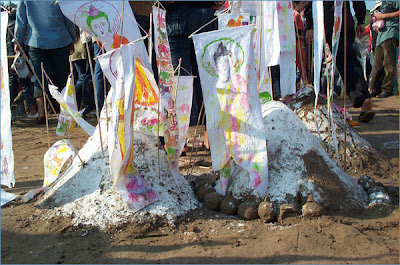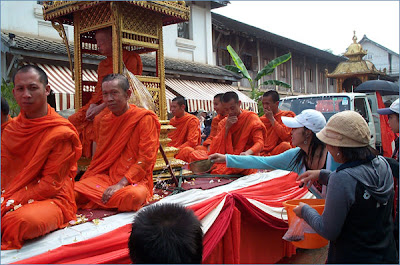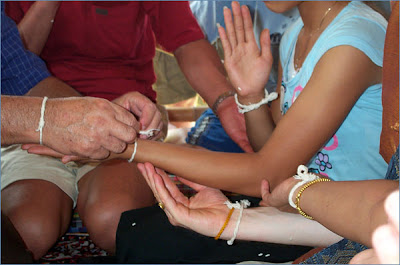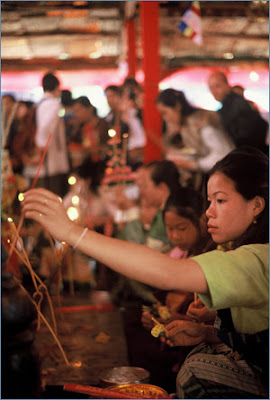Its a celebration like no other on the festival-packed Laos calendar: Seeing out the old year in Luang Prabang and ushering in the new, with waterfights, solemn temple-going and elaborate parades. And the setting couldnt be more magical, in the former royal capital at the junction of the Mekong and Khan Rivers, nestled among the mist-shrouded mountains of Laos north.
Lao New Year, or Pii Mai, occurs in mid-April and marks the beginning of the new Lao agricultural year, with rain expected any day. As if throwing back a blanket, the town wakes up and a time-honoured drama unfolds for five days, including a day between the end of the old year and the start of the new when time literally stands still and the Lao are said not to age.
On the first day of rituals, head to talaat nat, where all the necessary festival items are for sale. Pairs of birds in tiny pink straw cages line up neatly on mats and chirp incessantly alongside fish in buckets being sloshed into small plastic bags, and restless turtles and frogs stretching against protective nets. Liberators of these animals will gain merit. Traditional Lao musical instruments are also hawked, along with carefully crafted noise-making instruments, helium balloons, sweets, soups and coconut ice cream. Streams of coloured paper, hand-painted with the signs of the Lao zodiac and mounted onto slim sticks, are carried along by the crowd. Gambling is popular. Throwing a tennis ball, aiming a dart, flicking a slingshot or spinning a fish can variously win you cigarettes, fish sauce or washing detergent.

Pa thaat sai on the far bank of the Mekong river
We stop at one of the wats along the road, and watch an older man show novices how to asperse or wash the temples Buddhas. This is one of the most serious rites of the new year, symbolising purity and life, as well as the renewal the rains will bring. Residents meanwhile line up with buckets of water or hoses outside their houses, dousing passers-by with a good-humoured splash or two, also a symbolic rite of purification.
Families catch boats to the other side of the Mekong to build pa thaat sai, stupas made of sand. Each grain used is said to wash away a single sin of the builder. The stupas are surrounded by small balls of mud sprinkled with flour, into which the Buddhist year is inscribed. Finally, the concoctions are decorated with incense and candles and a prayer and family snaps follow. It's late afternoon when in what feels like a finale, a Lao Aviation plane swoops down the river, metres over our heads as mouths drop open in response to this centurys addition to tradition.

Monks enroute to the temple
On the day sandwiched between the two years, at Wat Ahaan the red masks of Pu No and Na No, the towns royal tutelary gods, are brought out from storage and preened for the days procession. People line the footpaths to ensure they get a good spot to see the parade through town. Water-dousing continues, with nobody spared. Tourists screaming Camera! No! get it down their backs while elegant women wearing traditional clothes get a delicate cupful instead of a bucket.
The procession is an endless stream of colour. City officials carrying pyramids of carefully arranged banana leaves and flowers feature as well as saffron-wrapped monks and novices who are splashed with rose-petal perfumed water. Pu No and Na No come next, accompanied by the little lion known as Singkeo Singkham. Pick up trucks carry abbots in litters. Women dress in intricately woven traditional sin and pabieng, or skirts and sashes; groups of men dance the /fon dab/, a traditional groove, when the parade arrives at sprawling Wat Sieng Thong. Pu No and Na No accept offerings from the people, before officially ending the day by performing a dance.
The following day the spirit of the new year arrives. At sunrise, monks are given fruits, sweets, cakes, flowers and money. At Phu Si, the hill dominating Luang Prabang, women kneel on mats with silver bowls, patiently waiting for the monks to arrive. Like rays of the arriving sunlight itself, the single file monks emerge eventually and accept their alms.

Baci ceremony
An hour later families arrive to walk up the frangipani-dotted hill to Wat Thaat Chom Si laden with rice, lollies and biscuits to propitiate the spirits. The offerings are left along the 328 steps leading all the way to the summit. Mist drifts through the mountains in the distance while the Nam Khan stretches like a lover below.
In the afternoon, yesterdays parade goes in the reverse direction and heads back to Wat Thaat Luang and is just as energising.
On the second day of the new year, Luang Prabang's residents head by boat to the Pak Ou caves 25 kilometres upstream to pay homage to the Buddha statues here. Children sell flowers, incense, orange candles and water perfumed with yellow, pink and white flower petals. People quietly sprinkle water over the statues as curlicues of smoke are caught in the flickering candlelight.

Making an offering
The rituals continue on the final day with a procession of the Pha Bang, the highly revered and tiny golden image of Buddha that originally came from Sri Lanka, via a king of Cambodia. Led again by Pu No and Na No, the Pha Bang is carried from the National Museum in a /prasat/, a carved wooden palace-like structure, to the courtyard of Wat Mai, in a short but joyous procession. Here the Pha Bang will stay under a marquee, illuminated by lights, for three more days and nights. Flowers, incense and candles are offered at such a rate that a few people are specially employed to remove them.
Some things may have changed rapidly in Laos, but many things, it seem, remain precisely the same.
More information
Travelfish publishes a series of PDF travel guides for travel to Southeast Asia.
Luang Prabang has it's own dedicated title, and also forms a part of their Laos pack.
Stuart McDonald is the Southeast Asia Editor for Wandering Educators.
